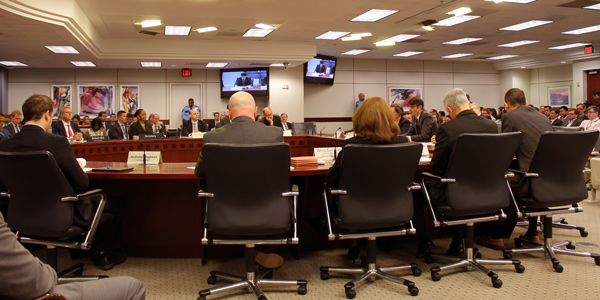By Michael Brooks
WASHINGTON — By now, it sounds like a broken record.
As they have in the past four years, the trends in natural gas dominated the discussion of FERC’s annual State of the Markets report at the commission’s open meeting on Thursday.
The report found that average U.S. natural gas spot prices rose 21% in 2017 from 2016, while average day-ahead on-peak LMPs increased 3 to 13% at pricing nodes in RTO/ISO markets.

FERC had a packed agenda for its open meeting April 19, including a presentation on the 2017 State of the Markets report. | © RTO Insider
While the previous two years were marked by cheap prices driven by warm winters, last year saw cold weather at both its beginning and end, with an especially severe cold snap at the end of December and into January 2018 leading to a sharp spike in prices, especially in ISO-NE. (See FERC, RTOs: Grid Performed Better in Jan. Cold Snap vs. 2014.)
Last year also marked the first since 1958 that the U.S. was a net exporter in gas, propelled by increased LNG export capacity. “The largest increase in demand for natural gas came from LNG exports, which rose from 0.63 Bcfd to 2.19 Bcfd, a 248% increase,” according to the report. Total exports to Mexico, the U.S.’ biggest LNG customer, increased by 0.5 Bcfd to an average 4.2 Bcfd for the year, aided by several new cross-border pipelines.

LaFleur | © RTO Insider
Gas producers also found new markets within the U.S. About 12 billion Bcfd and 773 miles of new pipeline capacity went into service last year, most of it in the Marcellus and Utica shales. “New pipeline capacity out of the Marcellus and Utica shale plays allowed producers to meet demand in previously inaccessible markets,” the report says. “These shale plays demonstrated the largest U.S. natural gas production growth in 2017, with a 10.3% year-over-year increase for a total production of 22.1 Bcfd by the end of 2017.” Total U.S. gas production rose 1.0%, averaging 73.6 Bcfd.
One of the only metrics to fall significantly was storage inventory. 2017 saw the third lowest weekly storage injection rate since 2010, while the end-of-year cold snap led to the largest withdrawal in history, 359 Bcf. The large winter withdrawals also led to the lowest end-of-winter storage level since 2014: 1.35 Tcf on April 5, 2018.
Commissioners Neil Chatterjee and Robert Powelson both noted the prevalence of gas in the report, focusing their comments on the importance of fuel security and gas-electric coordination to grid reliability.

McIntyre | © RTO Insider
“Staff’s report indicates that at the beginning of last year, fuel security was already a particular concern within New England and Southern California because of limited natural gas transportation and storage infrastructure, and that by last winter, those concerns had grown into real anxiety,” Chatterjee said. Noting the cold snap in the East and pipeline outages in California, “I look back at 2017 as the year of close calls that underscore the importance of examining fuel-security issues,” he said.
“The analytics … in today’s report are really a testimony to the benefits of organized markets and what they do in terms of providing reliability,” Powelson said.
He said he was concerned about the phaseout of the Aliso Canyon storage facility in California, noting the state’s aggressive renewable portfolio standard, the closure of several nuclear plants there and, in what he called “the “who-would-have-thunk-it moment,” commission-approved reliability-must-run contracts for gas units in CAISO. He called these, along with the high prices in New England, “alarming situations.”
The report was released right after FERC issued a Notice of Inquiry to review its 1999 policy statement on natural gas pipelines. (See related story, FERC Outlines Gas Pipeline Rule Review.)




